ShodhKosh: Journal of Visual and Performing ArtsISSN (Online): 2582-7472
|
|
Practice and Exploration of the Atmosphere Construction of Digital Media
Huansong Yang 1![]()
![]() ,
YouYou Zhang 1
,
YouYou Zhang 1![]()
![]()
1 College
of Culture, Creativity and Media, Hangzhou Normal University, Hangzhou, China
|
|
ABSTRACT |
||
|
With the
booming development of the digital media industry, the demand for related
professionals is growing. As the cradle of talent training, the construction
of digital media laboratory atmosphere plays a crucial role in the
cultivation of students' professional skills and innovative ability. Taking
the Digital Media Laboratory of Hangzhou Normal University as a case, this
paper elaborates how to improve and enhance the learning atmosphere of the
laboratory through multi-dimensional means such as the optimization of hardware
facilities, the enrichment of teaching resources, the interaction and
communication between teachers and students, and the cooperation between
schools and enterprises. At the same time, through practice and exploration,
this paper puts forward some suggestions on the construction of digital media
professional laboratory atmosphere, which aims to provide reference for the
construction of similar laboratories in other universities. |
|||
|
Received 13 May 2024 Accepted 05 August 2024 Published 08 August 2024 Corresponding Author YouYou Zhang, 1020028574@qq.com DOI 10.29121/shodhkosh.v5.i2.2024.1408 Funding: Ministry of
Education Industry-University Cooperative Education Project "Research on
Innovation Atmosphere Construction and Practice of Digital Media Professional
Laboratory in Universities" (Project number: 230803579203205). Copyright: © 2024 The
Author(s). This work is licensed under a Creative Commons
Attribution 4.0 International License. With the
license CC-BY, authors retain the copyright, allowing anyone to download,
reuse, re-print, modify, distribute, and/or copy their contribution. The work
must be properly attributed to its author.
|
|||
|
Keywords: Digital Media Professional Lab, Laboratory
Atmosphere Construction, University Education, Practice and
Exploration |
|||
1. INTRODUCTION
In recent years, the rapid development of digital media technology is profoundly changing all aspects of society, from film and television production to online games, from social media to virtual reality, digital media has become one of the most active areas of innovation. Digital media laboratory is an important base for teaching and research of digital media in colleges and universities, and its construction quality is directly related to the training quality and discipline development of digital media and other related professionals. As an important base for cultivating future digital media professionals, the laboratory atmosphere of colleges and universities directly affects the cultivation of students' learning effect and innovation ability. Therefore, building a positive, open and innovative laboratory atmosphere has important theoretical value and practical significance for stimulating students' creativity and practical ability.
At present, many scholars at home and abroad have recognized the important role of digital media laboratory in higher education, and have conducted extensive research on laboratory construction and management. Foreign universities generally attach importance to the construction of laboratory environment, pay attention to the combination of practical teaching and theoretical research, and form some mature management models and teaching methods. This is closely related to the development of computer technology in foreign countries, the rapid development of computer technology in foreign countries, the use of cross-management teaching and discipline integration management education in the teaching of various professional fields, so that each laboratory involving computer technology has a high utilization rate, remarkable results, and can effectively play the actual teaching advantages in the teaching of various majors. In Western Europe and North America, the construction of university computer laboratories is relatively complete, which not only has professional practical ability, but also provides a powerful environment for students to deeply explore professional learning resources. Through the creation of a good computer laboratory teaching environment, students can have independent spatial thinking and thinking ability, so as to cultivate good learning habits and the spirit of research. Make it in the future professional research and development and learning. Zhang & Feng (2014)
Although Chinese universities have made some achievements in the construction of digital media laboratories, there are still some problems and deficiencies in the construction of laboratory atmosphere, such as uneven allocation of resources, weak teachers, and lagging teaching content update. At present, there is a lack of planning for the construction of digital media laboratories in our country, and the construction of laboratories in many universities has not considered the diversified design templates, which has resulted in a certain waste of resources. Although many universities in China have formed the concept of digital media laboratory construction, the insufficient investment in infrastructure management and maintenance leads to the inadequate maintenance and management of laboratory equipment, which affects the teaching quality. Even in China's teaching system, the formalization phenomenon is very serious. In order to control construction costs and save equipment maintenance costs, some colleges and universities fail to fully arrange students to enter the digital media lab for practical operation in the course design, so that students do not effectively grasp the key points of digital media technology, which has a certain impact on the in-depth practice and exploration of subsequent students. The Pedagogy of the Oppressed, written by Brazilian educator Paulo Freire, aims to awaken and cultivate people's critical consciousness and practice humanized liberation education. It reveals the importance of critical study in general education and proposes that humanization is the core value and starting point of liberation education. The construction of digital media laboratory in China should also fully consider the problems existing in the learning process of students, effectively design and utilize the laboratory according to the learning needs of students, and fully consider the professional ability and practical experience of students after leaving the school in the teaching planning and design, so as to achieve the compatibility of curriculum Settings, the integrity of facilities and the humanization of teaching mode. In China's teaching system, too many theoretical courses have become a major pain point for practical majors. It is undeniable that theoretical courses are very important to improve students' knowledge system, but the heavy theoretical work also makes students have no time to improve practical operation skills, which runs counter to the original intention of the curriculum of colleges and universities. The energy, cost and attention of universities to practical technical laboratories are far less than those of foreign countries. In conclusion, the laboratory is a place to cultivate students' practical ability. A good laboratory atmosphere can stimulate students' curiosity and thirst for knowledge, make them more actively participate in experiments and practical activities, better master digital media-related skills, improve practical operation ability, and also help cultivate students' innovative thinking and independent thinking ability. Encourage them to try and explore new digital media products or works of art. But there are some problems in the construction of laboratory in our country, through practice and exploration, this paper puts forward some suggestions on the construction of digital media professional laboratory atmosphere, in order to provide reference and reference for the construction and development of digital media professional laboratory.
2. Overview of university digital media
professional laboratory
Digital media major is a new interdisciplinary major, which combines the knowledge and skills of computer science, communication technology, art design and other fields. This major mainly cultivates students' comprehensive ability in digital media content creation, editing and communication, as well as their ability to adapt and apply new media technologies. With the development of Internet and mobile communication technology, the digital media industry has shown an explosive growth trend, and the demand for related professionals is also increasing. The laboratory is an important part of the teaching of digital media majors, which provides students with a platform to simulate a real working environment, so that students can learn and master professional knowledge in practice. In the laboratory, students can complete the whole process from creative conception to work production by operating professional equipment and software. In addition, the laboratory is also the main place for students to conduct scientific research activities, project cooperation and skill competitions, which plays an irreplaceable role in cultivating students' innovative thinking and teamwork ability.
The basic principles of university digital media professional laboratory mainly include the following points:
1) People-oriented: The construction and development of the laboratory should meet the teaching and scientific research needs of teachers and students as the core, pay attention to the human factor, and provide teachers and students with a good learning and research environment.
2) Scientific management: The laboratory should establish a sound management system to ensure the efficient and orderly operation of the laboratory. Scientific management includes the standardization and supervision of laboratory hardware facilities, experimental teaching, scientific research work, safety and other aspects.
3) Resource sharing: Digital media professional laboratories in universities should realize resource sharing to improve equipment utilization. Through reasonable planning of laboratory resources, ensure that students and teachers of different disciplines and specialties can share laboratory resources.
4) Open sharing: The laboratory should be open to both inside and outside the school to provide experimental technical services and support. Encourage faculty and students to participate in academic exchanges and cooperation at home and abroad to enhance the influence and visibility of the laboratory.
5) Innovation leadership: The laboratory should focus on the innovative research of digital media technology and keep up with the development trend of the industry. Encourage teachers and students to carry out cutting-edge technology research and practice, and cultivate talents with innovative spirit and practical ability.
6) Safety first: Laboratory safety management is an important part of laboratory construction. Strengthen laboratory safety education, formulate emergency plans for safety accidents, and ensure the safe operation of laboratories.
7) Sustainable development: Laboratory construction should pay attention to sustainable development, and reasonably plan the direction and scale of laboratory development. On the basis of meeting the existing needs, reserve certain development space to adapt to the rapid development of the digital media field in the future.
8) Combination of production, university and research: The laboratory should cooperate with enterprises and scientific research institutions to strengthen the combination of production, university and research and promote the transformation of scientific research results. Through industry-university-research cooperation, the laboratory's practical teaching level and scientific research ability are improved.
9) Optimize the environment: The laboratory should create a good academic atmosphere to promote the exchange and cooperation between teachers and students. Optimize the laboratory environment and improve the efficiency and comfort of the laboratory.
10) Innovative practice: The laboratory should pay attention to practical teaching and the cultivation of innovative ability, and encourage students to participate in experiments, practices and scientific research activities.
11) Respect for intellectual property rights: The laboratory shall respect intellectual property rights, abide by relevant laws and regulations, and protect the legitimate rights and interests of intellectual property owners.
12) Evaluation and feedback: Establish a laboratory evaluation system and conduct regular evaluation of the construction and development of the laboratory. According to the evaluation results, timely adjust the laboratory construction strategy and continuously improve the laboratory work.
Taken together, these principles aim to ensure that the laboratory can effectively support the teaching and research activities of the digital media profession, while developing students' practical skills and innovative capabilities to meet society's demand for highly qualified digital media professionals.
3. Practice of digital media specialty
laboratory construction in colleges and universities
The practice of digital media laboratory construction is a systematic project involving many aspects, including hardware facility construction, software environment construction, teaching and research activities, laboratory management and so on. Liu (2016) Taking some of the achievements of the production-education integration engineering base project of Zhejiang digital cultural and creative industry that the author is responsible for as an example, the following are some key practical steps:
1) Clear laboratory construction objectives: First of all, universities need to clarify the construction objectives of digital media professional laboratories, which usually include improving teaching quality, promoting scientific research and innovation, strengthening practical teaching links, and cultivating students' comprehensive ability. Sun (2015) Therefore, Hangzhou Normal University took the lead in coordinating and establishing the leading group of Hangzhou Normal University Digital Cultural and Creative Industry Production-Education Integration Engineering Base, organized and implemented the project of Hangzhou Normal University Digital cultural and creative Industry Production-education integration Engineering Base, optimized the structure of teaching staff, further summarized the professional characteristics, highlighted the teaching construction and reform, and deepened the practical teaching of production-education integration. We will promote a mechanism for coordinated education between schools and enterprises.
2) Formulate detailed laboratory construction plans: Based on the objectives, formulate specific plans for laboratory construction, including laboratory scale, function positioning, hardware facility configuration, software environment construction, laboratory management system, etc. Fully consider the sustainable development and expansion of the laboratory to meet the needs of future discipline development and technology upgrading.
Figure 1

|
Figure 1 Post-Film Laboratory |
Figure 2

|
Figure 2 Testing Laboratory of Film and Television Works |
Figure 3

|
Figure 3 Digital Studio |
3) Hardware facilities construction: According to the needs of digital media majors, configure the corresponding hardware facilities, such as high-performance computers, graphics workstations, 3D printers, professional photography and video equipment, audio equipment, editing equipment, etc. At the same time, ensure that the hardware facilities are updated and maintained to meet the needs of technological development.
Figure 4

|
Figure 4 3D Printing Lab |
Figure 5
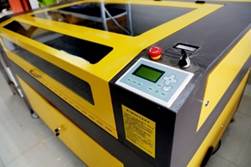
|
Figure 5 Product Model Making Laboratory |
Figure 6
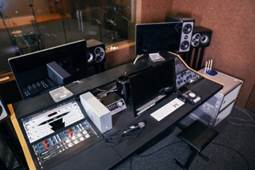
|
Figure 6 Recording STUDIO |
4) Software environment construction: In addition to hardware facilities, software environment is equally important. This includes the procurement and updating of professional software, the optimization of the network environment, the construction of cloud computing and big data platforms.
Figure 7
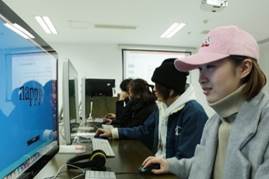
|
Figure 7 Film Editing Laboratory |
Figure 8
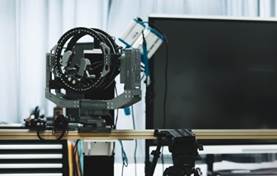
|
Figure 8 Stop Motion Animation Lab |
Figure 9
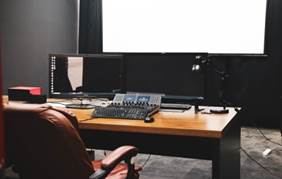
|
Figure 9 Digital Color Correction Lab |
5) Teaching and research activities: The laboratory should become an important place for teaching and research. Carry out experimental courses and provide practical operation platform; Encourage faculty and students to undertake research projects and promote the output of research results. Focusing on the requirements of the construction of digital cultural and creative professional groups, we will further promote the construction of professional connotation, constantly optimize the talent training program, innovate the talent training mechanism, and plan the cultivation and construction projects such as courses, teaching materials, and education reform.
6) Laboratory management: Establish and improve laboratory management systems, including laboratory use norms, safety management systems, equipment maintenance systems, etc. At the same time, strengthen the construction of laboratory team, improve the professional quality and service level of laboratory management personnel.
7) Industry-university-research cooperation: Establish cooperative relations with enterprises and scientific research institutions, promote the transformation of laboratory research results, and provide internship and employment opportunities for students. The author held a meeting on the integration of industry and education in digital culture and creativity, and conducted exchanges on the "government-enterprise-school-community" talent joint training model and the construction of the integration model of industry, university and research in drama, film and television, new media communication, and cultural and creative industries. The author invited many industry front-line experts from Zhongnan Cartoon, Full Speed Group, Ayou Culture and Technology and other well-known cultural and art creation research institutes to participate in the discussion. In the aspects of curriculum development, textbook compilation, teacher appointment, scientific research transformation, entrepreneurship guidance, etc., promote the integration of professional groups with industry enterprises and scientific research institutions, and gradually realize the docking of majors and industries, the docking of training objectives and industry needs, and the docking of training specifications and jobs.
8) Academic atmosphere: Create a positive academic atmosphere by holding lectures, seminars, competitions and other activities to stimulate students' innovative consciousness and scientific research interest.
9) Continuous improvement and optimization: evaluate and feedback the laboratory construction regularly, adjust the laboratory construction strategy according to the evaluation results, and continuously improve and optimize the laboratory construction.
10) Student participation and feedback: Encourage students to actively participate in the construction and management of the laboratory, collect students' opinions and suggestions on laboratory construction, and constantly improve laboratory services.
Through the above practical steps, the university digital media professional laboratory can effectively improve its service quality, better serve the teaching and scientific research, and train more excellent digital media professionals.
4. University digital media professional
laboratory application effect
In his book Pedagogy of the Oppressed, Paul Freire argues that leaders (teachers) transform their students' dependence into independence through genuine educational action based on trust in the oppressed. Paul (2017) Therefore, the assessment of the application effect of digital media professional laboratories in colleges and universities should not only be based on the gradual improvement of the construction of laboratory hardware facilities, but also should be evaluated from multiple dimensions, including teaching quality, students' learning outcomes, academic atmosphere, laboratory resource utilization, scientific research and innovation ability cultivation, industry-university-research cooperation effect, social service ability, etc. From the above dimensions, to implement the effects of students' use of laboratory learning, the following is to take some of the achievements of Hangzhou Normal University digital cultural and creative industry integration engineering base project as an example.
Teaching quality: The laboratory provides a platform for practical teaching, so that students can combine theoretical knowledge with practical operation, and improve students' hands-on ability and practical skills. Through hands-on teaching in the lab, students are able to better understand and master digital media-related technologies and tools. During the project, the author's college was approved as the national animation first-class undergraduate major construction site; The three courses of "Color Basis", "Graphic Programming" and "Animation Scene Design" were awarded the provincial first-class courses; Won the Ministry of Education industry-university cooperative education project 2.
Improving the quality of student works: The lab provides students with hardware and software support to create digital media works, so that the quality of students' works is improved. In the laboratory, students can carry out creative activities such as image processing, video production and animation design, and cultivate their artistic accomplishment and innovative thinking. During the project, our students participated in Class I and Class II discipline competitions and won a total of 111 awards, including 25 China competitions and 86 provincial competitions. A total of 1263 students participated and 951 works were submitted.
Active academic atmosphere: The laboratory has become an important place for academic exchange, and regular lectures, seminars and other activities have promoted academic discussions and exchanges between teachers and students, and stimulated students' academic interest and creativity. During the project, the school initiated a number of professional group cultivation projects, including 3 textbook construction projects, 4 teaching reform projects and 4 quality course projects; Held a meeting on the integration of digital culture and creativity, production and education, and actively explored the application-oriented talent training model of "government-enterprise-school-community" integration.
Improved utilization of laboratory resources: Through reasonable planning and effective management, the utilization of laboratory resources has been improved. The equipment and facilities of the laboratory have been fully utilized to provide better learning and research conditions for students and teachers.
Scientific research innovation ability: The laboratory provides a place and resources for scientific research and innovation for teachers and students. Teachers can use the laboratory to conduct research on scientific research projects and improve the quality of scientific research results; Students have the opportunity to participate in research projects, develop research interests and innovation ability. The school held a seminar on the discipline construction of Drama and film and television and the practical teaching of Master of Arts degree, and hired more than 20 front-line experts in the drama and film industry to serve as industry tutors, further consolidating and improving the team of tutors; Successfully established the "Creative Arts" graduate academic Forum, Creative Arts - Huifeng Youth Image Competition, Huifeng - Snow Reading Club, and formed a system to be held regularly, further mobilizing students' academic enthusiasm and enhancing the academic atmosphere; Pay close attention to dissertations and works, improve the standard of degree awarding; Sponsor students to publish papers, participate in discipline competitions and academic conferences; Encourage students to create art, and jointly hold Huifeng original image Competition with a number of film and television institutions and universities in Hangzhou to provide platform support for students' practice.
Deepening of industry-university-research cooperation: The cooperation between the laboratory and enterprises and other scientific research institutions promotes the integration of industry-university-research, making teaching and research closer to the needs of industrial development. Such cooperation helps students better understand industry dynamics and improve their competitiveness in employment. In terms of talent mechanism, the discipline has continuously improved its cooperation with various enterprises and institutions, and gradually established a characteristic teaching model featuring government guidance, industry participation, social support, and dual-subject education of schools and enterprises. The school where the author works has improved 15 research and creation communities for teachers and students, including drama and film Review Center, online short video research and creation studio, documentary production studio, script editing and creation studio, stage beauty poster creation studio, and Qiantang River Basin traditional festival research Studio. With the "second classroom" function of the Research and Innovation Center, it complements and optimizes traditional classroom teaching and AIDS scientific research. At present, relying on the curriculum construction, the studio has covered more than 40% of the professional courses of the graduate students, and more than 60% of the students participate in the faculty innovation and research projects.
Enhanced social service ability: The laboratory can not only serve the teaching and scientific research within the university, but also provide technical services and support for the society. The social practice of students in the college of the author is combined with the problems of "insufficient feelings of home and country, unfamiliar local customs and people, and low professional quality", and goes into the grassroots and deep into the countryside to serve the development of the countryside. In Chun 'an, Hangzhou, we carried out the construction of the cultural and creative living room of "number wisdom leading and service sharing" to create "one township and one product". In Deqing, by interviewing veterans and inheritors of intangible cultural heritage to resist the US and aid North Korea, we will deeply cultivate red and characteristic culture and expand the research on the practice center of civilization in the new era. In Xiaoshan, Hangzhou, we built a "Common prosperity broadcast room" with New Youth Group and Wasu Qiusuo Channel to empower the transformation and upgrading of rural culture. The social practice project won the national key project and was rated as the excellent team of social practice in Zhejiang Province, and the social practice results were reported by China Education Online, Hangzhou Daily, Urban Express and other media.
To sum up, the application effect of the digital media professional laboratory in universities is reflected in the improvement of teaching, scientific research, industry-university-research cooperation, academic atmosphere, the quality of students' works, resource utilization and social service ability. The realization of these effects will help cultivate more digital media professionals with practical ability and innovative spirit, and promote the development of digital media-related fields.
5. Conclusions
With the popularization and development of digital media education in China, the construction of digital media laboratories in universities has made remarkable achievements. Hangzhou Normal University has established a digital media lab equipped with advanced equipment and technology to provide students with high-quality learning resources. These laboratories are usually equipped with professional audio and video editing equipment, animation production software, 3D printers, etc., to meet the teaching needs of different courses. In addition, Hangzhou Normal University has also established cooperative relations with enterprises in the industry, introduced practical project cases, and enhanced the practicality and application of the laboratory. This paper makes an in-depth study on the practice and exploration of the atmosphere construction of digital media professional laboratory in colleges and universities. The research shows that through the optimal allocation of hardware facilities, the enrichment and integration of teaching resources, the construction of teacher-student interaction and exchange mechanism, the construction of school-enterprise cooperation and practice platform, and the cultivation of cultural atmosphere and innovation consciousness, the learning environment of the laboratory can be effectively improved and the overall development of students can be promoted. The case analysis shows that the implementation of these measures can improve the participation and satisfaction of students, and enhance the attraction of the laboratory and the teaching effect.
Based on the research findings, the following recommendations are made in this paper: First, universities should continue to invest in keeping the laboratory hardware facilities modern and efficient operation. Secondly, the development and updating of teaching resources should be strengthened to ensure that the teaching content is synchronized with the development of the industry. Thirdly, it is suggested that universities should establish a more open platform for teacher-student interaction and encourage students to participate in the laboratory management and decision-making process. In addition, universities should deepen cooperation between schools and enterprises to provide more practical and employment opportunities for students. Finally, colleges and universities should pay attention to cultivating students' innovative spirit and teamwork ability, and create a positive laboratory cultural atmosphere by organizing diversified cultural and innovative activities.
CONFLICT OF INTERESTS
None.
ACKNOWLEDGMENTS
None.
REFERENCES
Liu, C. (2016). Strategies to Improve
the Teaching Quality of
Digital Media LABS in Universities. Education and Teaching Forum, 52, 167-168.
Paul, F. (2017). 30th Anniversary Edition of Pedagogy of the Oppressed [M]. Gu Jianxin, Zhao Youhua, He Shurong, trans. Shanghai: East China Normal University
Press.
Sun, X. (2015). Construction of Digital Media Laboratory under School-Enterprise Cooperation Model. Career Space and Time, 31, 42-44.
Zhang, M., & Feng, W. (2014). The Characteristics and Enlightenment of the Construction of Foreign Child Development Laboratories -- A Case Study of Illinois. The Child Development Laboratory of University of Champaign as an Example, 5, 78-81.
|
|
 This work is licensed under a: Creative Commons Attribution 4.0 International License
This work is licensed under a: Creative Commons Attribution 4.0 International License
© ShodhKosh 2024. All Rights Reserved.

